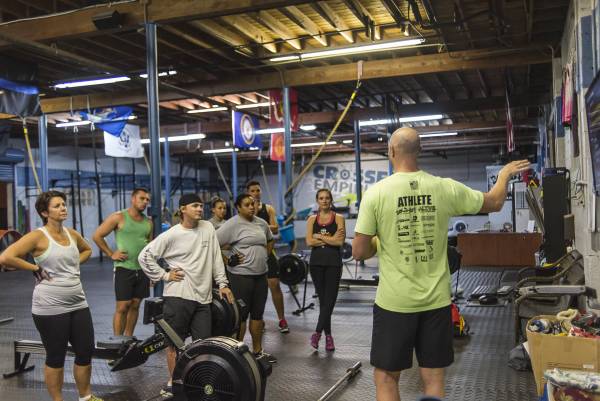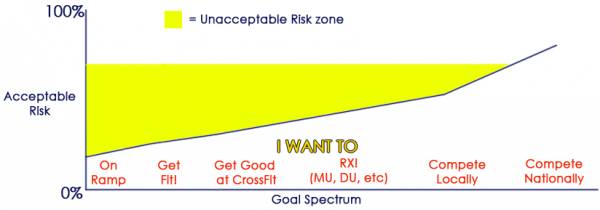Risk, in the context of how we humans move through the world, means the probability of injury, disease, or death under specific circumstances. “Acceptable risk” risk means the how much of said injury, disease, or death we as a society will tolerate in order to achieve whatever result we wish to achieve.
Life and Death
In layman’s terms, imagine you’re standing at the edge of a bridge with a bungee cord wrapped around your ankles, talking to the puka-shelled bungee operator named “Devin.”
You: “Is this safe?”
Him: “Well, you could die”
That’s risk. Take it one step further.
You: “Die? How likely am I to die?”
Him: “Dude, the odds are miniscule. I’ve never had an accident in ten years of operating, and my cables are inspected weekly by the Bungee Safety Association of the Americas.”
That’s acceptable risk. Yes, you can still die but the result you wish to achieve is the massive adrenaline rush. And, when weighing that tiny risk of death against the huge payoff, you are willing to accept that risk. If the risk of death were one-in-four, you would likely choose not to jump.
“The complete elimination of risk in CrossFit obviously is an unachievable and impractical goal. But risk of injury can be mitigated into the acceptable risk level.“
Planes and CrossFit
The aviation industry is a perfect example of acceptable risk. They say this:
The complete elimination of risk in aviation operations obviously is an unachievable and impractical goal (being perfectly safe means to stop all aviation activities and to ground all aircraft) … In other words, it is accepted that there will be some residual risk of harm to people, property or environment, but this is considered to be acceptable or tolerable by the responsible authority and the society.1
Now, substitute aviation with CrossFit:
The complete elimination of risk in CrossFit obviously is an unachievable and impractical goal (being perfectly safe means to stop all fitness activities and to ground all asses on the couch) … In other words, it is accepted that there will be some residual risk of harm, but this is considered to be acceptable or tolerable by the CrossFitter.
The risk of injury, disease, or death is all around us all the time. We live on a tightrope that not only can snap at any moment, but at the end of which none of us will ultimately emerge alive. With that, let’s consider acceptable risk and CrossFit.

As anyone who follows my writing knows, I am an advocate for smart, safe, and effective training. I am interested in goals-oriented training. This means your training methodology should align with where on the spectrum of fitness you wish to be. If you wish to simply get fit, you need one training prescription. If you wish to compete locally, another prescription. If your goal is to compete nationally, then you require yet another, much more intense, level of training.
With each of those goals comes a higher risk of injury. Make no mistake, though (and yes, I am about to say these words) – there is a risk of injury with functional fitness training from your basic on-ramp course through to the CrossFit Games themselves. The key is aligning the acceptable risk of injury with your goals.
Where We Fail
We have all heard the statement that any activity, even if allegedly unsafe, is better than rotting on the couch. I agree. No one will argue that some level of physical activity is better than no level of physical activity.
“I am interested in goals-oriented training. This means your training methodology should align with where on the spectrum of fitness you wish to be.“
Where I believe we sometimes fail as a community of coaches, trainers, and programmers, is falling prey to the myth that there is a single line of demarcation – on one side of which lies CrossFit and on the other side a sedentary life – and that all you need to do is hop over the line and you are now a “CrossFitter.” And as such, you are now privy to the kingdom of all that being a CrossFitter offers, from Isabel, to kipping pull ups, to muscle up attempts, to deadlifts.

The reality is we need to view our clientele almost as an entire room full of personal training clients. With each client possessing a separate set of goals, abilities, and tools. It is essential that you know your clients’ goals and where they wish to be on the spectrum so you can adjust their exposure to acceptable risk accordingly.
In other words, if each person in the room has different goals, then why is everyone doing “Isabel” together? (Pro-tip: merely scaling the weight is not the answer.)
Assessing Appropriate Injury Risk
Let’s look at my wholly unscientific graph. On the X axis, you see the spectrum of possible goals for anyone entering the CrossFit world, from just getting fit to being a national competitor. On the Y axis is the level of acceptable risk of injury.

Notice that even at on-ramp level, the risk of injury does not begin at zero. That’s because even walking in the door carries with it some minor risk of a scraped shin, tweaked back, or roughed-up shoulders. At the risk of stating the obvious, you can see that the people wishing to compete on the national stage need to be willing to tolerate a high risk of injury. For those just wanting to live longer, better lives, a very small risk tolerance should be in place.
The yellow area above each goal point represents the unacceptable risk of injury. Your job as a trainer is to make sure what your clients are doing falls under the acceptable risk line, based on their goals. Therein lies the rub. How can you keep your clients progressing toward their goals without slipping dangerously into the yellow zone?
And what exactly is in that yellow zone? It’s filled with novice athletes flailing around on a pull-up bar without even being able to do a strict pull up. It’s a gang of brand-new athletes standing around the rings trying their luck at muscle ups without having so much as a ring dip to their name. It’s older athletes going into a WOD cold without sufficient warm up to prepare them to train. It’s that athlete who insists on putting the prescribed weight on the bar who has no business doing so.
It’s also having a class full of CrossFItters all doing the same damn thing.

While that may seem antithetical to the nature of CrossFit, it’s in keeping with the idea that you must be in tune with the goals of your clients in order to help them succeed and keep them safe. For example, if you have a 55-year-old female whose goal is to get fit, then she likely never needs to do a single kipping pull up or any type of workout like “Grace” with high-rep Olympic lifts. You can help her achieve her goals without those things.
It’s About Risk Management
The complete elimination of risk in CrossFit obviously is an unachievable and impractical goal. But risk of injury can be mitigated into the acceptable risk level. It starts with asking the question, to each and every client: “Where do you want to be at this time next year”?
Check out these related articles:
- A Not-So-Scientific Look at Injury In CrossFit
- The Great Injury Debate – Is CrossFit Dangerous?
- How to Injury Proof Your CrossFit
- What’s New On Pulse Beat Fit Today
References:
1. “Risk Management.” Sky Library, last accessed March 24, 2015.
Photo 1 courtesy of Shutterstock.
Photos 2, 3, and 4 courtesy of CrossFit Empirical.






